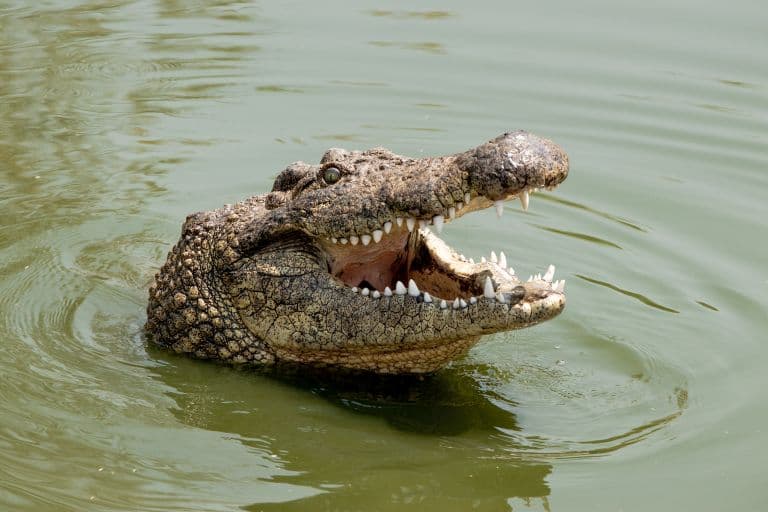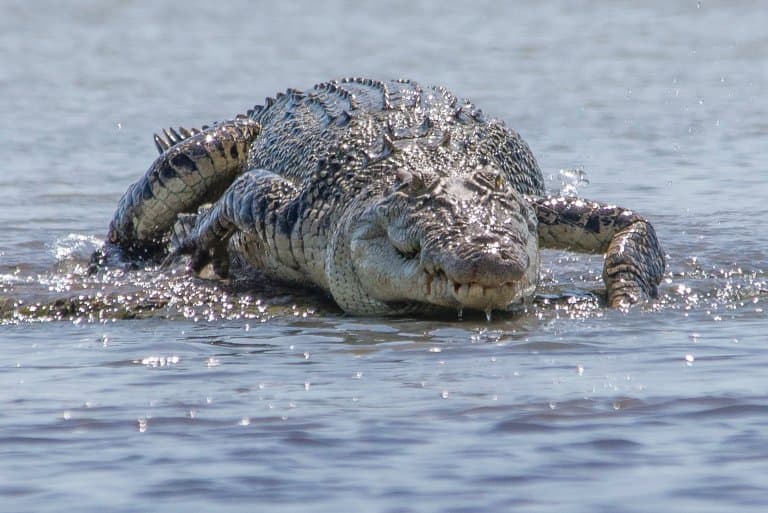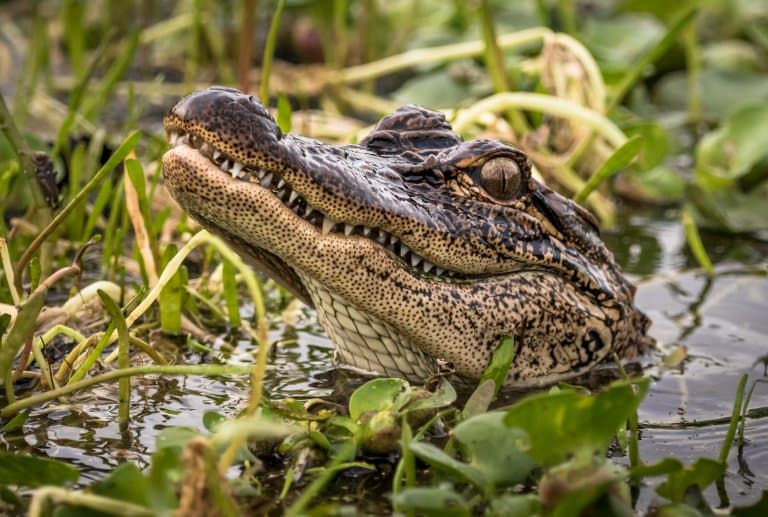Crocodilians are perhaps the most prehistoric-looking animals on the planet, and as an order, they’re survivors of the K-T Extinction event that killed off the dinosaurs and 80% of all animal species.
Today, while they look a lot like huge lizards, they’re more closely related to birds than to other reptiles, having diverged from the ancestor of modern birds around 250 million years ago.
Some of the largest crocodile-like animals to have ever lived, like Sarcosuchus imperator and the marine giant Machimosaurus rex, would have reached more than 10m long and weighed up to eight tonnes. But these huge crocodiles were only distant ancestors of modern crocodilians, predating the order at around 120 million years ago.
Today, crocodilians can be grouped into three main families: The gharials, in the Gavialidae family: Indian crocodilians distinctive for their slender, long snouts; and Crocodylidae and Alligatoridae, the crocodiles and alligators, respectively.
These two are harder to differentiate, and with such a widespread distribution, there’s some overlap in their habitats.

So, what really is the difference between an alligator and a crocodile?
1. They’re slow to evolve
Crocodiles and alligators diverged around 90 million years ago. That’s plenty of time to grow into very different animals. For perspective, that’s around the same time that the first primates diverged from other placental mammals, while we were all just small, mouse-like creatures.
But while primates have created such stark differences as that which exists between mice and men, the genome for alligators and crocs has evolved much slower, and in terms of percentage DNA shared, the difference is much closer to that of humans and baboons: crocs and Alligators share roughly 93% of their DNA.
This explains why they’re still so similar-looking, but doesn’t really help differentiate one from the other, so let’s look at some other factors. 1
2. Crocs are all over the place
Alligators were once prevalent all over the globe, but now comprise only two species, both in the genus Alligator:
In the Southern US, there is the American alligator, a large and powerful crocodilian that grows up to nearly 500 kg and primarily feeds on the annoying little dogs of retired Floridians.
Then, there is the relatively diminutive Asian variety, the Chinese alligator. This one rarely tops 50kg and is restricted to just three Northeastern Chinese provinces.
The very limited distribution of alligators represents a collapse of their populations all over the globe, having once been widespread across tropical and subtropical regions.
Crocodiles, on the other hand, are far more numerous and diverse. There are 18 species known and one in the pipeline, and there is generally very little overlap in their distribution.
But at risk of confusing things a little, the Caiman, a South American Alligartoid, is a third branch of crocodilian, more closely related to alligators than crocs, but neither one nor the other.
So, let’s look a little closer at this distribution.

3. They rarely share a habitat
If you’re in Australia, having your leg torn off by a large crocodilian, it’s likely to be a crocodile. There are no native alligators in Australia, New Guinea, or even most of Asia, so if you’re in these places and you spot a crocodilian, it’s likely to be a crocodile.
Africa, too, has no alligator species left, and conversely, most of South America has no crocs. There is overlap in Northern South America, Central America and the Southernmost tip of Florida, where both crocs and alligators are native, but for the most part, their distributions are very different.
Still, if you’re in one of these overlapping zones, you might have to rely on other clues, such as what kind of water you’re in when it bites you, to identify it. 2
4. Crocs are salty
Alligators are primarily freshwater animals, while crocs spread out into marine ecosystems too. So, while you do get freshwater crocs, if it’s in the ocean, it won’t be an alligator.
American crocs inhabit brackish waters, and even freshwater species tend to prefer estuarine environments where possible. Alligators love ponds, swamps and lakes. So, in general, if it’s in still, freshwater, it’s more likely to be an alligator.
Australia, of course, has both freshwater and saltwater crocs, so this rule can’t be followed here and you’d have to refer back to rule 3. 3
5. Crocs grow larger
The largest alligators are nothing to sniff at. Record-holding examples include one from Florida that was almost six meters long and weighed 473 kilograms (1,043 lbs). But this is an exceptional example, and for the most part, and an average large male is around half this size.
Crocodiles also occasionally come in small packages, with the West African dwarf croc holding the title of smallest crocodile at 1.8 meters (5.9 feet) long.
But on the whole, croc species are larger than alligators and pack more of a punch. The largest croc on record was around 7 meters long and weighed over a tonne, more than twice that of the largest alligator. Crocodiles are said to be more aggressive in general, too.
Adult salties commonly hit four meters and weigh over 600kg, while the average chunky American alligator is around 3 meters long and rarely over 400kg.
But these are very slow-growing and long-lived animals, so unless you’re looking at the largest croc, you might be faced with a juvenile. So, using size alone isn’t going to help you. You’ll have to get a closer look at its face. 4

6. They have different heads
Alligators are most recognisable by their wide, U-shaped snouts. Crocs generally have a narrower mouth, and even in huge species will look more triangular from the top down.
Narrower snouts tend to be more generalist in terms of what they’re capable of. A skinny nose is good for catching fish, but can also grab a large mammal from the river bank if it comes along. Alligators, on the other hand, are built for crushing.
They usually go for larger prey animals, relative to their size, but also things like turtles, which need a powerful crushing bite to break into.
But if you’re not standing over it and you’re looking at these faces side-on, you can spot a difference in the way its jaws close. When the wide jaw of an alligator closes, its lower teeth disappear completely. A croc’s teeth protrude into the classic ominous grin of the world’s most infamous extant reptile.

7. Crocs can gallop
This is probably at the lower end of the priority list if you’re ever near a sprinting crocodilian, but if you have the wherewithal, try to get a look at its gait.
Both crocs and alligators can run at around 17-18 km/h (11 mph), but alligators do so in a trot. Crocs, on the other hand, can switch into a fearsome gallop, so if you see all four legs off the ground at once, it’s a crocodile.
This has something to do with the length of the limbs. Alligators have much shorter humerus (upper arm) and femur (thigh) bones than crocs, which makes them stockier and waddling. 5
8. Crocodiles have salt glands
If you stood too long trying to pay attention to how it was running, chances are you’re now close enough to examine its tongue.
Crocodiles have lingual salt glands that help them keep their blood isotonic in the presence of salty foods. Just take a very close look at the side of the tongue and you might be able to spot them.
The coastal environment of crocodiles also determines their colour. Crocs are generally lighter, and more sandy in colour, while alligators are a darker, swampy green.
If they’re not there, you’re probably dealing with an alligator. 6
Final Thoughts
So there you have it – alligators versus crocodiles! Can you spot the differences?
There are tons of similarities between crocs and alligators. And each difference between them seems to come with its handful of exceptions.
On the whole, though, the best way to tell an alligator from a crocodile is the check out the snout. The face shapes are recognisably different with a bit of practice, and even the exception to this rule, the broad-snouted mugger croc Crocodylus palustris, still has more of a V than any alligator you’ll come across.
Fact Sources & References
- https://www.amarillo.com/story/news/2014/08/30/alligator-or-crocodile/13202289007/
- https://education.nationalgeographic.org/resource/crocodilian-ranges/
- https://www.dcceew.gov.au/sites/default/files/env/pages/dc11235d-8b3b-43f7-b991-8429f477a1d4/files/40-fauna-2a-crocodylia-morphology.pdf
- https://www.dnr.sc.gov/marine/mrri/acechar/speciesgallery/Reptiles/AmericanAlligator/index.html
- https://www.covetrus.co.uk/crocodiles-can-gallop-but-alligators-cant-new-study-finds/
- https://www.researchgate.net/figure/Fig-l-a-d-Tongues-of-crocodylids-a-b-and-alligatorids-c-d-showing-lingual-gland_fig1_226925683
